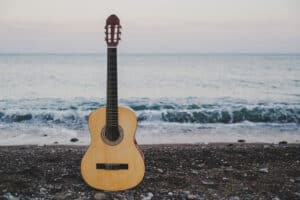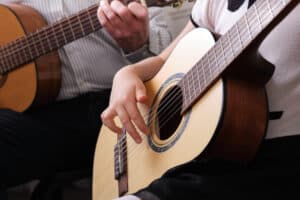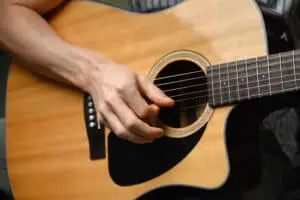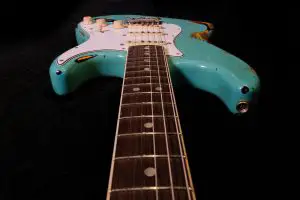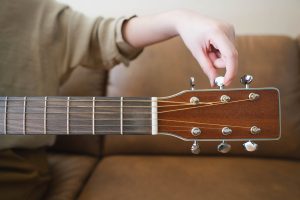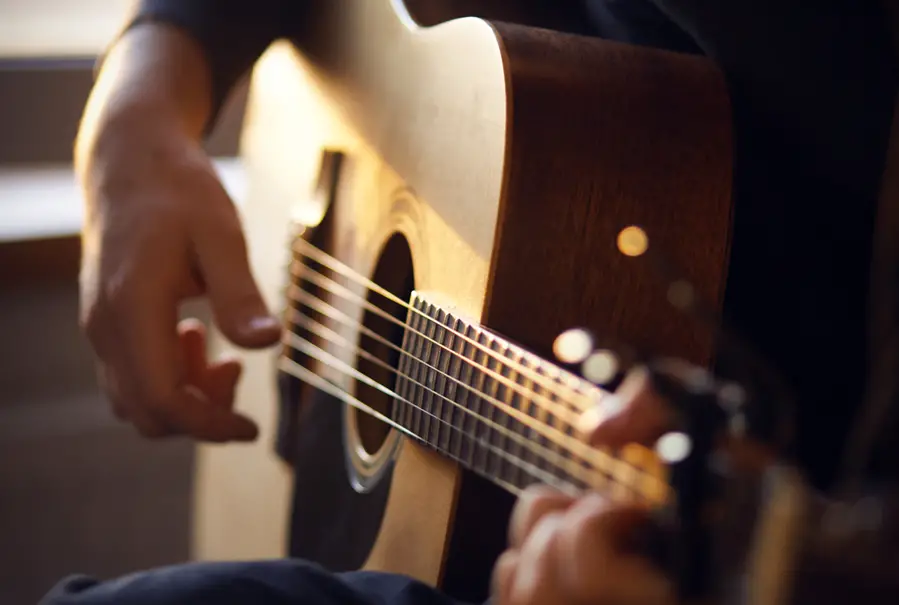
There’s a reason why the guitar is the second most played instrument in the world. Its versatility and distinct sound are why thousands of people choose to learn the instrument every year.
Some learn because they love the instrument and plan to be the next Jimi Hendrix or Eric Clapton. Others heard a song they loved so much and wanted to be able to play it themself.
But, whichever category you fall in, your understanding of notes and chord progression will determine the quality of the rhythms you’ll create.
Chord arrangements are simply the backbone of any sound you plan to play with the guitar.
So what guitar chords go together?
This is a question with dozens of answers. Chord progressions are only limited to your creativity and imagination, but some of the more popular chords that go together are:
- A, D, E;
- D, G, A;
- C, F, Bb, F;
- G, Em, C, F;
- C, Am, F, G.
These are just some of the most common chord progressions; there are over a hundred available. Here, we’ll show more of these progressions, plus tips on knowing and joining chords together yourself.
Understanding Guitar Chord Progressions

Before you venture into guitar chords and their combinations, you must have a decent knowledge of guitar notes. Without guitar notes, you won’t understand how scales or chords work.
Most people tend to interchange the terms; notes and chords, but they are both different. A chord is a set of guitar notes played together either simultaneously or sequentially. It usually takes three notes to form a chord. For example, the A Minor chord is made up of A, C, and E notes.
The A note is called the root note, and playing them all together will create the A Minor Chord.
Now let’s move on to some chords that can be played together:
The G, C, D, and Em Group
If you’re a beginner and new to the guitar, this should be the first group of chords you learn.
The G, C, and D chords combo is probably the most common guitar chord combination. It was used in the songs Lively Up Yourself by Bob Marley and Hound Dog by Elvis Presley.
They are the 1, 4, 5, and 6 chords in the G Major key. This chord combo is loved and recommended for beginners because it can be played in any order and still produce good rhythms.
Here are some progressions you can play with the G, C, D, and Em Group:
- G-C-D (I-IV-V/ 1-5-4 progression)
- G-D-Am-C ( I-V-vi-IV/ 1-5-6-4 progression)
- G-C (I-IV/ 1-4 progression)
- G-D-C ( I-V-IV/ 1-5-4 progression)
The C, F, G, and Am Group
The C, F, G, and Am Group is another group of chords you should try if you’re new to chord theory. Like the above group of chords, they are very popular and are frequently used in most songs we hear today.
This group of chords might be more complicated for beginners because of its use of the ‘F’ barre chord. However, with some variations on the F, you are not required to bar the entire first fret.
A barre chord is a type of chord that’s played by pressing the fingers against multiple strings in a single fret. It’s like creating another nut.
Also, these chords will still sound good no matter the order you play them. In the song Demons by Imagine Dragons, the C, G, Am, F progression is used. If you’re looking to take lessons on this particular group of chords, Demons by Imagine Dragons is a good song to practice with.
Here are some other progressions you can play with the C, F, G, and Am Group:
- C-G-Am-F ( I-V-vi-IV/ 1-5-6-4 progression)
- C-F-G ( I-IV-V/ 1-4-5 progression)
- C-G-F ( I-V-IV/ 1-5-4 progression)
- C-F ( I-IV/ 1-4 progression)
The D, G, A, and Bm Group
Like the already listed groups, this is another popular one that uses the 1, 4, 5, and 6 chords, except for this time; it’s in the key of D Major.
Bm is a barre chord, and one of the reasons this group’s sound is distinct and refreshing. The BM chord can singlehandedly change a song’s mood by making it a bit somber.
You can even line up the chords in any way, as heard in Bon Jovi’s It’s My Life. In this song’s chorus, he uses the Bm-G-D-A chord progression.
Here are some other progressions you can play with the D, G, A, and Bm Group:
- D-A-Bm-G (I-V-vi-IV/ 1-5-6-4 progression)
- Bm-G-D-A ( VI-vi-V-I/ 4-6-5-1 progression)
- D-G-A (I-IV-V/ 1-4-5 progression)
- D-A-G (I-V-IV/ 1-5-4 progression)
- D-G ( I-IV/ 1-4 progression)
The Am, G, F, and E Group
The first minor key on our list is a relative to the C major. If you’re into rock music, you must have heard this group of chords a thousand times. They are also common in pop music. Walk, Don’t Run by The Ventures is a popular song that uses this chord progression.
Here are some other progressions you can play with the Am, G, F, and E Group:
- Am-F-G (i-VI-VII/ 1-6-7 progression)
- Am-G-F(i-VII-VI/ 1-7-6 progression)
These are the most common chord progressions you can play, especially if you’re a beginner. There are dozens of other chord progressions you can try out.
Here is a list of chords that go well together:
- C – F – G
- A – D – E
- E – A – B
- D – G – A
- F – Bb – C
- G – C – D
The Bottom Line
Most of the songs we hear today are products of two or more chords being played together. If you’ve gone deep into chord progressions, you’ll discover that thousands of songs share the same chord progressions, with very minute changes made.
Some of the most popular chord groups are the Am, G, F, and E Group; G, C, D, and Em Group; C, F, G, and Am Group; and the D, G, A, and Bm Group.
The good thing about chords is that you can get creative with them. You can modify these progressions by adding other chords.
Let your ears guide you as you explore the plethora of chord possibilities. You might just stumble on something impressive.
Frequently Asked Questions
The G, C, and D chords are the most used guitar chords. They are used across most genres of music and can be heard in thousands of songs. This is mostly because they are one of the easiest chord progressions to learn.
The easiest chords to learn on the guitar are the C, G, D, and Em chords. They use lots of open strings and are closer to the guitar’s nut.
There are seven chords every guitar player should know: The G major, C major, D major, A minor, A major, E minor, and E major. These chords will allow you to play any song you want to play on the guitar.

